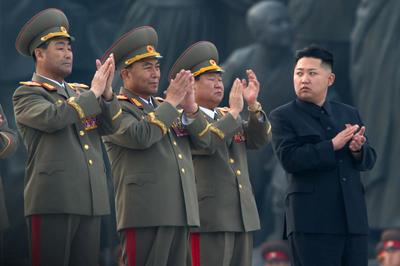However, Pyongyang’s defence planning highlights problems of how to use its limited resources. The resource management dilemmas in North Korea are critical, given that it simply cannot muster enough resources to alleviate the imbalance between force structure and operational preparedness in the over-sized, over-politicised KPA. These operational problems in the KPA open up a myriad of vulnerabilities to its mobilisation capabilities.
Since the death of Kim Jong-il, Pyongyang has strived to centralise and politicise the KPA under Kim Jong-un’s leadership. While Kim Jong-un may be heading the Workers’ Party of Korea (WPK) and the National Defence Commission (NDC), he is flanked by his uncle, Jang Song-taek, and aunt, Kim Kyong-hui. At the same time, we are also seeing generational changes in the upper echelons of the military chain of command, with the appointment of key figures such as Choe Ryong-hae (vice chairman of the WPK Central Military Commission, director of the KPA General Political Bureau and a member of the NDC), Vice Marshal Ri Yong-ho (Chief of General Staff), and Kim Jong-gak (Minister of People’s Armed Forces). The appointment of these cronies further hardens North Korea’s over-politicised approach to defence planning. More recently, the removal of Ri Yong-ho from all positions and the appointment of Vice Marshal Hyun Yong-chol as the new Chief of General Staff further highlight just how much the party’s ideological values are prioritised over the military role of field generals.
The politicised nature of Pyongyang’s defence planning also stems from a management regime that aims to achieve an ambitious and symbolic military power. In 1962, Kim Il-sung issued the dang ui gunsa roson (Military Lines of the Party), which aimed to modernise the entire KPA, establish a cadre-based military, ensure nationwide fortification, and arm all citizens. To finance this, Kim carved out a chunk of the state’s economy for the military and established an indigenous military-industrial complex ― the Second Economic Committee. Ironically, Pyongyang’s political ambitions exceed its economic capacity, triggering dilemmas for Pyongyang as it allocates capability building resources to individual components of the KPA.
While a politicised approach to defence planning may bolster the leadership’s domestic political security, it is a distraction when it comes to prioritising military systems acquisitions and operational preparedness. Ever since Pyongyang constructed its ideological stronghold, the North Korean government has been ingrained with the belief that modernisation is not so much about technological innovation and more to do with the innovative application of existing technology for asymmetric military attacks against South Korea. To preserve its political legitimacy, Pyongyang will continue to develop ideologically symbolic capabilities.
North Korea has shown signs of reconfiguring its mobilisation capabilities. Regarding force structure, there have been some notable developments in the KPA, such as the increased mobilisation of artillery/Multiple Launch Rockets (MLR), amphibious capabilities, submarines, special operations forces, and cyber/electronic warfare capabilities. As for operational preparedness, some modest developments are evident in the increase in training hours for tactical fighter pilots, and attempts to promote greater coordination between the air, ground and naval forces, as seen in the ‘Combined Manoeuvres’ exercises held on numerous occasions since January 2010.
These developments point to a diversification in the KPA’s conventional capabilities. Offensively, the KPA’s diversified preparedness is designed to strengthen the coordination and mobilisation capabilities of existing forward-deployed units. On the defensive side, the developments strengthen the KPA’s ‘tripwire’ capabilities along the Demilitarized Zone and Northern Limit Line. The common denominator is that Pyongyang is diversifying the KPA’s capabilities to penetrate vulnerabilities in the ROK’s defences and the US-ROK alliance (such as the Cheonan and the Yeonpyeong Island incidents in 2010).
Yet, the KPA’s capabilities continue to suffer from many weaknesses, and it will take time for Pyongyang’s defence planning adjustments to take effect. Shortcomings in North Korea’s conventional forces include: a lack of power projection capabilities, aging platforms, poor logistics, a shortage of resources, a weakening organisational structure, and declining health and morale among soldiers. These shortfalls constrain the KPA from operating beyond its immediate periphery, and also from fighting prolonged wars.
Complicating matters for North Korea, its strategic weapons program has been slower coming than the regime desired. In other words, Pyongyang may not be completely confident about managing its WMDs or aligning these weapons to their overall national strategy. Despite North Korea’s intense efforts to develop nuclear, chemical and biological weapons, questions remain over the operational effectiveness of the delivery systems (ballistic missiles), especially when considering the low success rate of test launches and the untested ability to mount miniaturised warheads on those missiles. Hence the diversification of the KPA’s capabilities could be interpreted as Pyongyang’s way of not only challenging the regional security balance but also compensating for shortfalls in its strategic weapons program.
To deal with North Korea, the US and its allies need to adopt a more expansive and flexible strategy. The US, Japan and South Korea should strengthen trilateral coordination and coherence in intelligence, reconnaissance and surveillance, as well as amphibious and air power projection capabilities to penetrate the KPA’s weaknesses. Moreover, the US alliance partners should coordinate and sharpen their force postures against the KPA’s increasing asymmetric military capabilities in order to counter future military provocations and instability on the Korean Peninsula.
North Korea’s diversifying mobilisation capabilities are part of its longstanding efforts to improve the KPA’s weaknesses. Symbolically, the developments ostensibly promote the KPA’s military readiness to protect North Korea as a ‘strong and prosperous nation’. Yet in substance, the increased reliance on asymmetric capabilities has failed to remedy the weaknesses of the KPA, or guarantee the third generation regime’s security.
Ryo Hinata-Yamaguchi is a Vasey Fellow at the Pacific Forum CSIS, Honolulu. He is a PhD candidate at the University of New South Wales, Canberra, and a Sergeant First Class in the Japan Ground Self-Defense Force Reserve Component. The views expressed in this article are entirely the author’s own.

